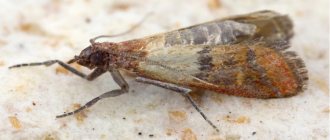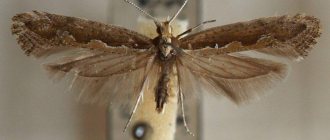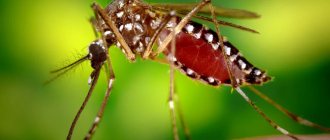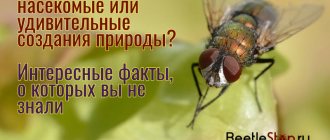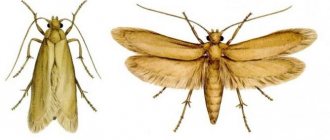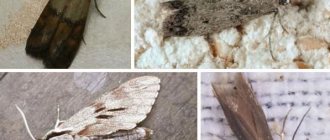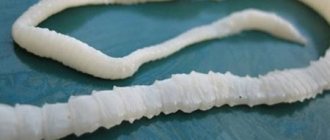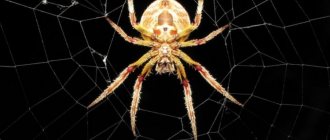Almost every resident of our country has found various pests in their home. But the most common question that arises even among clean housewives is how to find moths and their larvae. After all, gray butterflies go out to explore housing only at night. It is even more difficult to find clutches of eggs and larvae, since they are located in secluded places, the existence of which must be known. Before you start fighting insects, you need to become familiar with the ways in which insects enter and spread.
Favorite places of moths
The food moth prefers groceries. She eats everything without exception:
- grain;
- cereal;
- hot spices;
- flour;
- cookies;
- sugar;
- breadcrumbs and other products.
Each species has its own food preferences, but often food butterflies do not disdain anything. This means that a pest can be found in any dry products. The larva eats the product and spins a silk cocoon. Rolls and lumps form in flour and cereals; nests with worms can be found in nuts.
Food moths fly poorly. She is not able to move between rooms on her own, and ends up in the apartment with things or food.
The food moth prefers groceries. She eats everything without exception
Signs of insects living in the house
Food moths are easier to detect due to their limited mobility. It is found only in the kitchen (or in the pantry with food supplies), directly in the products, namely:
- cereals;
- tea;
- bakery and confectionery products, gingerbread;
- pasta;
- flour;
- nuts;
- dried fruits;
- chocolate;
- sunflower seeds;
- oatmeal and other cereals.
It lives within the package, where egg laying occurs. You can detect it by the following signs:
- lumps in bulk products (pictured) are a kind of cocoon that moths form with the help of crushed food particles;
- a cobweb by which you can identify insects in bulk products and on kitchen furniture;
- feces visible as fine black matter in food or powder on cupboard shelves;
- if the moth infestation area contains a large population of insects, a large number of dead moths and the remains of cocoons from which the larvae hatched are visible in the products.
Clothes moths reveal themselves at a late stage. When she appears to our thunderous applause, we clap our hands at the end of the performance: the winged insect multiplies very quickly and makes several clutches in the three weeks that she is allowed to live. She lays eggs in crevices, corners of cabinets, and on the bottom surface of shelves. If moths feed on furniture upholstery, then you should look for cocoons under the seats of chairs and armchairs, under the bottom of cabinets, on the legs of beds and sofas, etc. In all cases, eggs are laid on clothing, which the hatched worm will feed on.
The larvae begin to feed at a monstrous speed, since their life is limited by nature for a very short time and they need to make the most of the food source in order to calmly go into the pupa, and when emerging from the cocoon in the adult stage, have time to lay eggs. In clothes moths, larvae can be isolated from bald spots in carpets or at the borders of damaged tissue. In fur and fleecy fabrics, moths may not be as visible.
What does a mole look like?
These are insects belonging to the order of butterflies. Their appearance directly depends on the species. Household pests are represented by the following types:
- food;
- wardrobe;
- grain;
- furniture butterfly.
The color is often inconspicuous - greenish, grayish. The sizes are small - up to 15 millimeters. An insect can place a nest in the house and in nature:
- rye;
- cabbage;
- apple
You can find out in more detail why moth larvae are dangerous by reading the corresponding article on our website.
Moths are insects belonging to the order of butterflies. The appearance of the moth directly depends on the species
What does a moth eat?
The domestic animal causes a lot of inconvenience indoors in the form of damaged things, products, and property.
Favorite delicacies of food moths
These insects are divided into several types. Therefore, they eat foods made from grains and flour. Another group of individuals loves dried fruits, sweets and confectionery products.
The range of products that this type of moth prefers:
- bread,
- dried fruits,
- pasta,
- chocolate,
- flour,
- flour pastries,
- cookie,
- nuts,
- candies,
- cereal,
- seeds,
- cereals.
Taste preferences of the duffel moth
This pest is divided into clothing, fur, wool, carpet, and furniture moths.
List of dungeon moth treats:
- knitwear,
- blankets,
- socks,
- products made from bird feathers,
- knitted hats,
- furniture upholstery,
- mittens,
- sheepskin coats,
- fur shoes,
- natural fur coats,
- felt slippers,
- felt boots,
- wool sweaters,
- carpets.
This is not the whole list, because the insect eats everything that consists of natural fiber. The pest can even ruin synthetic linen if it contains cotton or wool.
Clothing that has been worn for a long time is also subject to attack if it contains particles of epidermis from human skin.
On a note!
Do not hide clothes in plastic bags. If a moth has chosen a thing, it will gnaw even such material!
Detection of food butterfly
This type of moth caterpillar typically feeds on solid food:
- cabbage;
- leaves, stems;
- cereal;
- nuts.
In some cases, the adult does not have a mouthparts and lives for less than a week.
The nest should be looked for either in or near food. Often this is an apple tree, cereals, cabbage. First, a small nest is formed. It contains larvae.
The food moth caterpillar typically feeds on solid food.
Black moth, photo, signs
If the golden moth is familiar to everyone, then the black one can cause bewilderment. An unprepared person does not understand what to expect from her and what she is all about.
As a rule, such moths are food-grade and live in cereals and flour in the kitchen. Those pests that fly around the kitchen are mostly males. Female black moths are much lighter in color and prefer to incubate their eggs in a nutrient medium. The lifespan of an adult black moth is only a couple of weeks, and during this time it needs to have time to lay as many eggs as possible.
Like other representatives of this species, the black moth is divided into fruit, cereal and flour varieties. This affects the food preferences of the larvae. The eggs look like dusty cobwebs. Once hatched, the moth larvae resemble hairless white caterpillars with a black or brown head. Their length is slightly less than one centimeter, but with good nutrition they can grow up to two cm. The long white body of the larva has six false legs - one pair at the head, the rest along the body. Their jaws work so well that they are able to chew through not only the hard shell of food, but also bags and even foil.
Having hatched, they begin to bite into grains with roots or dried fruits in order to penetrate inside and continue their growth there. The larva develops within four or five weeks, easily processing and digesting food. If its habitat is warm and humid, it grows even faster.
Surrounded by a nutrient medium, they reach thirteen millimeters and pupate. The cocoons are light brown, made of cobwebs, ranging from six to thirteen centimeters in length. Eventually, an adult moth emerges from the cocoon. After release, food becomes secondary for her, and mating and laying eggs comes to the fore.
Its main danger is that it multiplies too quickly for the pest. If her stay in the house lasts for one or two months, all supplies will be spoiled. The presence of larvae in the cereal, in addition to the notorious “cobweb”, can be identified by the presence of dust from gnawed grains. In addition, they are detected by glued pieces of cobwebs and discarded skins.
According to signs, a black moth foreshadows the sudden and rapid death of one of the household members. This can happen within a month to a year.
Signs of a pest
The presence of moths is indicated by the presence of eggs. But finding them is quite difficult due to their small size. In the closet, if you look carefully, you can see a large number of threads of cobwebs and pupae.
Flying insects usually do not go unnoticed. If there are 2 or more individuals in the apartment, you should immediately arm yourself with a flashlight and begin inspecting the premises. Carefully check in places where cereals are stored, in things made from natural fabrics, in kitchen furniture.
Finding moth eggs is quite difficult due to their small size
There are moths: what to do?
Once the nest of the pest butterfly has been found, you should immediately begin to destroy it. It should be remembered that the insect starts in dark places that are poorly ventilated. If you constantly ventilate things and cupboards with cereals, then you don’t have to worry about the appearance of a harmful butterfly. In cases where it is too late to engage in prevention, it should be taken into account that all insects cannot tolerate strong odors, so you can scare off adult insects from places that are attractive to them using drugs that have a pronounced aroma.
If the question of how to detect moths in an apartment has been resolved, and the insect was found in a closet with clothes, you need to go through all the things and take them out for airing. It is advisable to wash wardrobe items in hot water; if the material of the items does not allow this, they can be treated with chemicals and then washed at the appropriate temperature or cleaned. Fur items must be aired on the balcony so that they freeze out or receive a dose of ultraviolet rays.
The food moth can be destroyed only if you completely get rid of contaminated products. After an inspection of the cabinets, they must be washed with vinegar or insecticide solutions that will kill insects hiding in the crevices of the furniture. After treatment with chemicals, food cabinets and shelves should be thoroughly washed with clean water or a baking soda solution.
It should be remembered that eggs and pupae are reliably protected from the action of many agents, so it is important to carry out secondary treatment after 1-2 weeks. In order not to worry about moths in the cereals and what to do, it is important to place special traps on the shelves or place items with a pungent odor before storing food. Essential oils of cedar and lavender, which can be applied to cotton pads, as well as wormwood or juniper branches, are perfect for these purposes.
To prevent nesting of flying pests in wardrobes, not only natural substances in the form of aromatic essential oils are used, but also chemical ones. Naphthalene and tricarbonyl chlorine crystals are excellent at repelling butterflies. When using these drugs, they must be securely hidden from children and pets, since the substances are toxic and can cause harm to any living organism, not just insect pests.
How to protect your home
It is important to know how to protect yourself from moths. Prevention will help protect your apartment from pests. The following measures are worth noting:
- use of special repellents;
- checking all food products after purchase;
- purchasing only those foods that can be eaten during the week;
- You should not purchase products in places where the products are sold at a very low price.
For moths, there are no more dangerous herbs with a strong odor:
- rosemary;
- sagebrush;
- lavender;
- tansy.
You can also use:
- horse chestnut;
- essential oils;
- vinegar;
- orange peel;
- strawberry or laundry soap.
Ways to control insects
First, it’s worth talking about safety and prevention measures, namely:
- You should always inspect food products in the store before you buy them, for the presence of cobwebs in the package, and if there are any, this will already indicate that someone was in the package before you and left their traces.
- Carefully inspect the pieces of furniture and clothing you buy for the presence of the same cobwebs.
- The use of folk remedies to prevent and repel harmful insects - to do this, you need to place bags of dried lavender or tansy, as well as citrus peels (orange/lemon, garlic cloves) in places where moths may appear.
- Clean your pets' fur after walking.
Chemical repellents for moths
If we are talking about a case where there are a lot of moths at home, then you will need to resort to the help of chemicals; fortunately, there are a lot of such drugs, but not all of them are effective and safe for human health. The oldest way to fight moths is dichlorvos and naphthalene, but modern moths are unlikely to be penetrated by naphthalene, and with dichlorvos you will most likely kill yourself, but not the moth.
For this reason, you should not skimp and buy in bulk special plates (or a repellent liquid composition) for the fumigator, which after 5-7 days will eliminate all the moths in your home. In addition to these proposed methods of solving the problem, you can get rid of unpleasant butterflies using insecticidal sections and aerosols, but remember that no matter what drug you choose, it always comes with instructions, and you should read them in advance, before you go out to the warpath with moths.
Use of chemical compounds
If you find a fairly large accumulation of moth larvae at home, then traditional methods of control may not be enough. For this reason, experts recommend using synthetic agents to treat infected areas. The main thing is to take into account that the main damage is not caused by adults. First of all, you need to fight the voracious moth larvae.
Remember that toxic aerosols and sprays should never be used in the kitchen. This can lead to poisoning of the entire family. Do not hesitate to throw away spoiled cereals and flour. Products damaged by moths can no longer be used for food. What to do in the kitchen where a moth larva was found?
Preventive methods
Basic rules for storing food in an apartment:
- All dry cereals must be checked for expiration date upon purchase. The best option is to move them into airtight containers while checking them for insects.
- In kitchen cabinets and drawers, paper “stickers” against moths with an outer sticky layer are placed on the walls. These signal strips will not only scare away insects, but will also immediately indicate the moment of their appearance. It will be enough to simply check the appearance of such indicators.
- Additionally, you can place homemade sachets with herbs or cedar moth balls. Strong odors will keep butterflies away from groceries.
Regular cleaning of furniture and ventilation of cabinets in the house is necessary to prevent the larvae from remaining at a comfortable room temperature.
Also, you should not keep dirty things in your wardrobe, because the remains of sweat are attractive to insects.
You should be especially careful when it comes to storing clothes for winter or summer outside the season. It is best to use vacuum sealed bags. If clothes are packed in fabric covers or trunks, then each protective bag should be equipped with a lavender sachet, since this plant best retains a stable scent for several months.
Furniture or carpets can be treated with insect repellent sprays, but this method is dangerous for allergy sufferers. Cedar balls or herbs will be an alternative solution.
If the threshold for an allergic reaction is too high, then a steam generator is needed in the house. This is the best pest repellent without side effects.
Sources
- https://OVreditelyah.ru/mol/vidy-moli
- https://lifeinsect.ru/vneshnij-vid-moli.html
- https://notklop.ru/mol/vidy-moli/
- https://eco-stolica.ru/%D0%B4%D0%B5%D0%B7%D0%B8%D0%BD%D1%81%D0%B5%D0%BA%D1%86%D0%B8 %D1%8F/%D0%BC%D0%BE%D0%BB%D1%8C/%D0%BE_%D0%BC%D0%BE%D0%BB%D1%8F%D1%85
- https://parazitdoma.ru/mol/kak-vyglyadi
- https://KlopVred.ru/mol/vidy-moli/
- https://apest.ru/mol/vidy-moli/kak-vyglyadit-mol/
- https://WikiParazit.ru/babochki-i-moshki/vidy-i-stadii-razvitiya-moli.html
- https://uborka-v-dome.ru/poleznyie-sovetyi/kak-najti-mol-v-kvartire.html
- https://lifeinsect.ru/vidy-moly.html
Description, life cycle and reproduction
The moth looks inconspicuous: it is a small butterfly of golden yellow or straw color, the wingspan is 15 mm. The insect is afraid of daylight, so it leads a nocturnal lifestyle. During her life cycle, the female manages to lay about 300 eggs. Flying butterflies do not harm clothes. Their digestive system does not function; they only consume water. The danger is posed by small caterpillars - the larvae of household moths.
Knowing how the pest reproduces, you can take preventative measures. At home, the insect prefers to breed in the folds of clothing. Females love dry and warm habitats. After mating, the female is ready to lay eggs within four hours. The higher the temperature, the faster the larvae will hatch from the eggs. Moths in apartments feed on keratins, which they obtain from home textiles: woolen fabrics, fur coats, fabric pads in furniture, curtains and carpets. She is especially attracted to worn clothes with traces of dirt and sweat.
The larvae have a translucent or light yellow body color, due to this the entire contents of their stomach are visible. There are eight short legs on the abdomen; the caterpillar's head is brown. The larvae reach a length of 12 mm, have powerful jaws and a voluminous digestive system. Thanks to this, clothes quickly become unusable, leaving gnawed tracks on the product.
If you see a flying clothes moth, then it is a male. Females do not know how to fly, they stay in one place, and the males fly to them themselves, finding them by a specific smell.
How they develop and reproduce
The development cycle is standard for this class of insects. Adults lay white or silvery microscopic eggs, from which small caterpillars emerge.
This phase of the moth's life is the most dangerous for fabrics and dry foods. During the growth process, the larva requires the maximum amount of food, and the structure of the insect's jaws allows it to process a large amount of material.
Breeding cycle
After the moths appear, their main function will only be reproduction.
Males die immediately after mating. Females end their lives after laying eggs, the number of which can reach several hundred.
Two types of insects
The most important factor is what type of moths you have flying around your home. There are two types of these insects: food and clothes. These small butterflies enter the house in different ways, and it can be difficult to detect their presence.
There is also the wax moth. It lives in bee hives, and a tincture based on its larvae has many medicinal properties.
Important! The pest appears most often where there is a huge food supply.
Moth repellent
As with other insects, eliminating moths requires a comprehensive approach. Therefore, you may have to use several means. Although, if you encounter a clothes moth, it will be easier to remove it, but after that protection or preventive measures are necessary.
The products available on the market are aimed at destroying adults or repelling them. After you achieve the disappearance of adult insects, you need to take care of protection and repellent methods from areas that are at risk of infestation.
It follows from this that a successful fight is possible if you correctly combine measures of destruction and deterrence.
In order to choose a remedy for moths, you need to familiarize yourself with the drugs presented in a wide range on sale.
